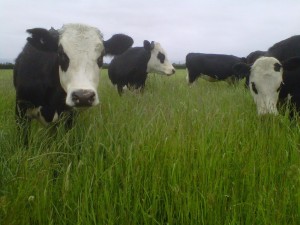Bottom Line of Soil
 Animals need food for two reasons – to produce energy; and to build new cells and grow, reproduce, repair injury, and produce milk or eggs.
Animals need food for two reasons – to produce energy; and to build new cells and grow, reproduce, repair injury, and produce milk or eggs.
Animals normally use carbohydrates and fats as “fuels”, although proteins can also be used for this purpose in times of starvation or excess. As far as growth is concerned, the essentials are proteins and minerals (calcium and phosphorus for bones and teeth, iron in the blood, sulphur in some amino acids).
But the cellular metabolic activities of both energy production (catabolism) and growth (anabolism) also require thousands of different enzymes, each of which consists of a protein and a cofactor (a mineral element or a vitamin). So, there is a need for vitamins and minerals such as copper, zinc, iron, calcium, potassium and magnesium.
Some minerals also perform other vital functions. Phosphorus is part of the energy-carrier molecule; sodium and potassium regulate internal water balance; chlorine and potassium regulate pH; iodine is part of the thyroid hormone.
And then there’s water – an essential nutrient substance as it is a necessary component of all living cells. Indeed, cells are mostly water – 70% in the case of an average animal cell.
The essentials
Some nutrient substances are essential in an animal’s diet; others can be manufactured within the animal’s body or cells. On the “essential” list are: calcium, phosphorus, sodium, potassium, chlorine, magnesium, iron, manganese, copper, zinc, fluorine, sulphur, iodine, cobalt.
Around 10 of the amino acids, and vitamins are also essential. However, in ruminants and most plant-feeding animals, some amino acids and vitamins are provided by the bacteria living in the digestive tract. Most animals apart from humans, monkeys and guinea pigs can manufacture their own vitamin C.
But there’s more to feeding animals than just the presence of the essential nutrients. They must be present in the proper amounts and proportions to ensure optimum good health. For example, a lactating cow needs a large daily supply of calcium, but just a touch of cobalt. Some elements, such as fluorine, are toxic in too-large amounts. Some interactions can damage animal health.
As is so often the case, good animal health depends not just on heaps of any old food, but on high-quality food in the right proportions.
The most precise way to determine the energy value of food is to count calories (kilojoules in the metric lingo) just as humans do. A calorie, or kilojoule, is a measure of heat energy (the amount of heat required to raise the temperature on one gram of water by 1Cº).
Another measure of food value is the biological value. It is not a direct measure of total food value, but of protein quality. It compares the relative proportions of essential amino acids in the food with the animal’s needs. A protein lacking any essential amino acid is a poor-quality protein.
All of this reinforces the message that the quality, not just the bulk, of food is extremely important in promoting animal health. And the amount of those amino acids is one of most important aspects of food quality.
The amino-acid production of plants grown in mineral-deficient soil has been shown to be unbalanced. And animals are known to grow better when fed food where all nutritional substances are in balance.
The bottom line

The bottom line of feeding agricultural animals is their efficiency in converting food into meat, milk, eggs or wool. This goes beyond just the digestibility and assimilation of food into body cells. Farmers are paid according to production, and quality is generally as important as quantity in determining prices.
Food efficiency also varies from species to species. Dairy cows are around 25% efficient in using food calories and 34% efficient in converting proteins into milk; a hen is 10% efficient for calories and 16% for proteins in egg production; a beef steer is 3% efficient for calories and 9% for proteins in producing meat.
There are other variables, too – the breed or variety of animal, the presence or absence of the various stresses, genetic variation of individual animals, and the quality of food the animal eats.
A small increase in food quality can lead to a much greater increase in food efficiency and production, and in farming efficiency. In some cases, less of the correct food can produce more output.
Sounds like farming paradise. So what’s the catch? It all goes back to the soil and the proper fertility for the plants that grow in it, and the flow-through effect to providing animals with the correct balance and quantity of feed.
But, as with most things, it all starts with the basics – in this case, the soil.

